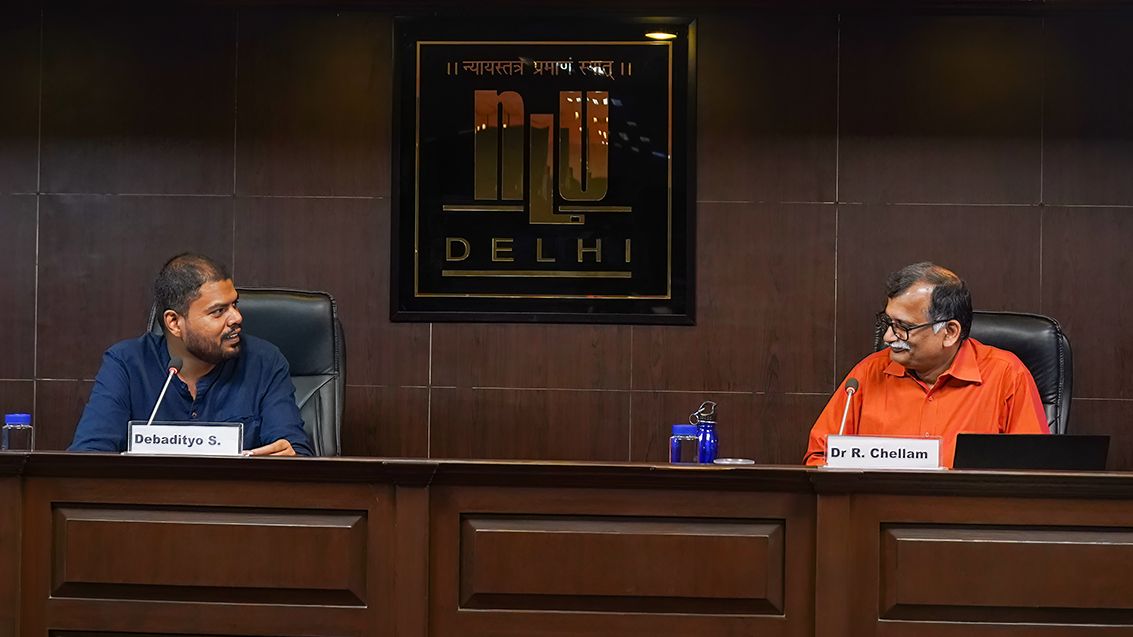The Vidhi Centre for Legal Policy and Rainmatter Foundation organised the first episode of Season 2 of THE GREEN MANDATE on ‘Afforestation, Reforestation & Eco-Restoration in India’ with noted wildlife conservationist and eco-restoration expert Dr. Faiyaz Khudsar. Forests play a crucial role in mitigating climate change, protecting against soil erosion, providing renewable resources, supporting local livelihoods, and preserving biodiversity. India aims to increase its forest cover to 33% of its land area by 2030, and afforestation is promoted through various policies and programs such as the National Afforestation and Eco-Development Board and the Green India Mission. The Compensatory Afforestation Fund Management and Planning Authority (CAMPA) oversees the management of funds to compensate for the loss of forest cover due to development projects. Afforestation campaigns are also gaining momentum in the civil society sector.
The discussion in the first episode of THE GREEN MANDATE Season 2 focused on the efficacy of forestation programs in India as a mitigation strategy for greenhouse gas emissions, and the need to develop a policy framework that can balance the benefits of climate mitigation, biodiversity conservation, and community benefits. The recording of the discussion is available on youtube following is a transcript of major discussion points from the talk.
Some of the highlights from the conversation can be found below:
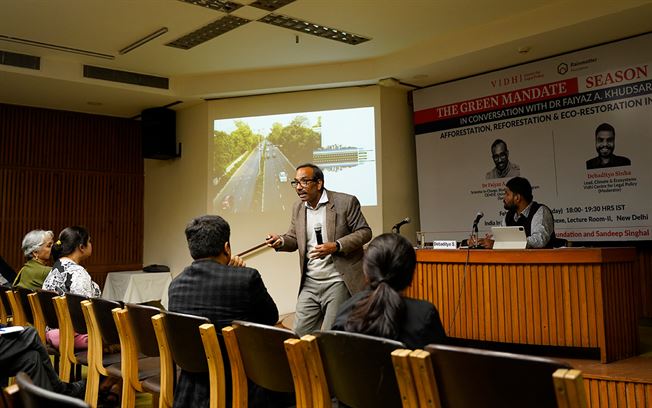
Dr. Faiyaz Khudsar speaking to the audience 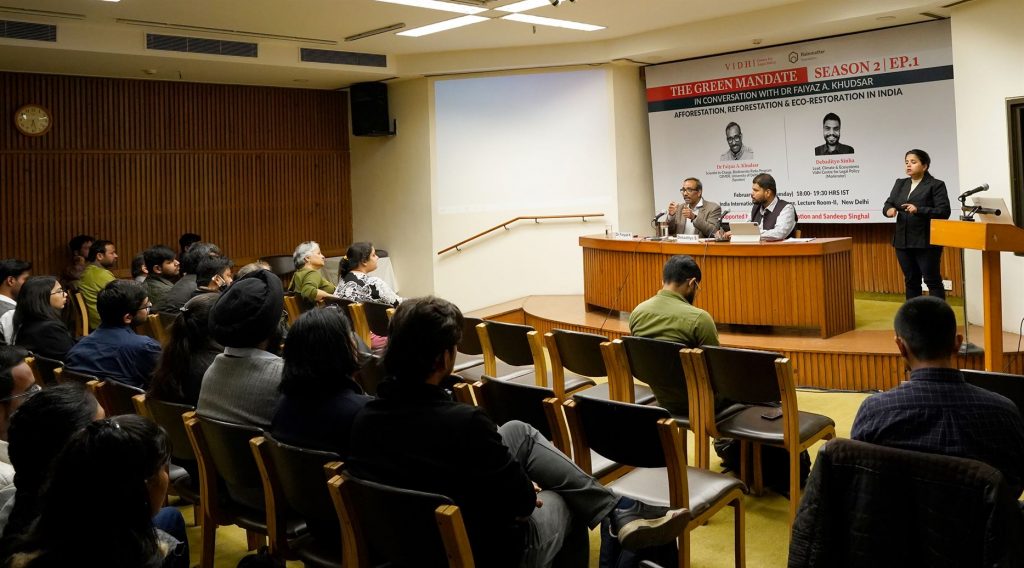
Dr. Faiyaz Khudsar in conversation with Debadityo Sinha 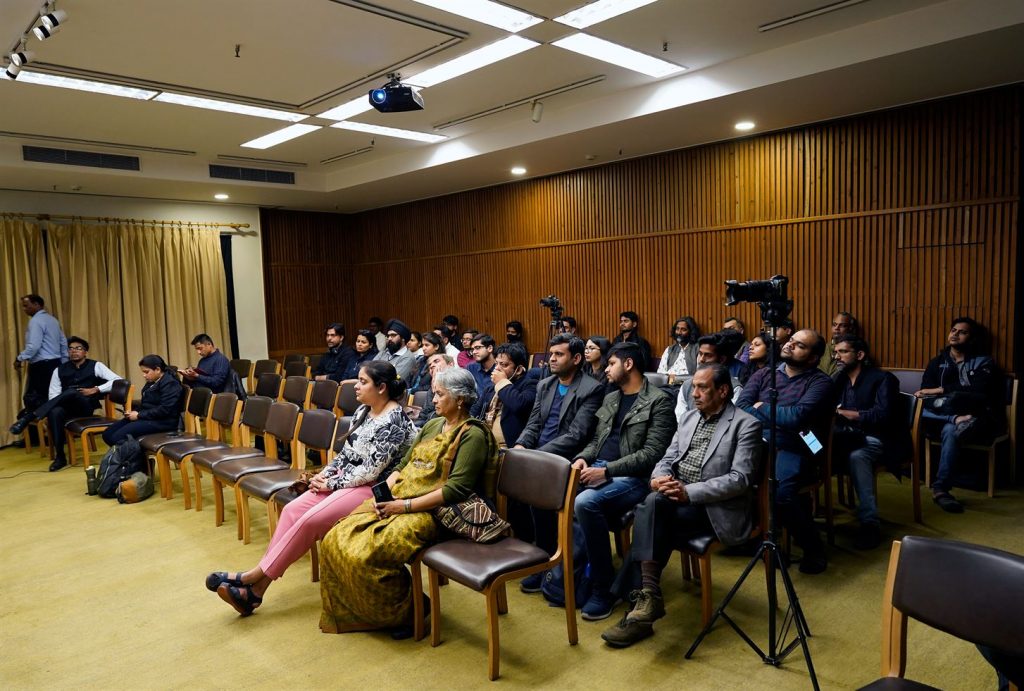
Image of the audience 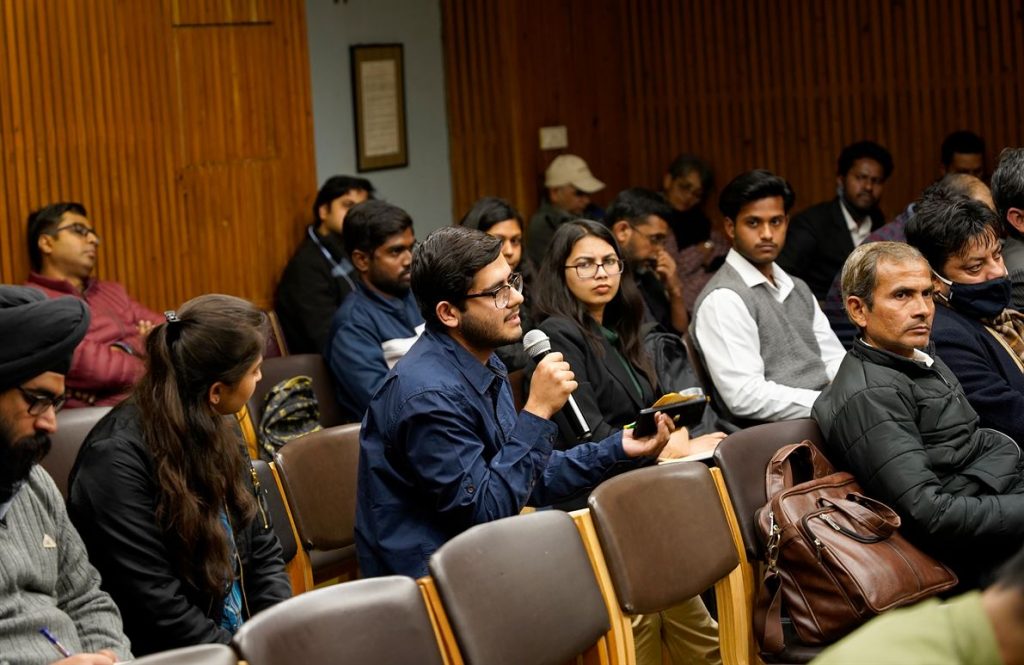
Participant asking a question to the speakers 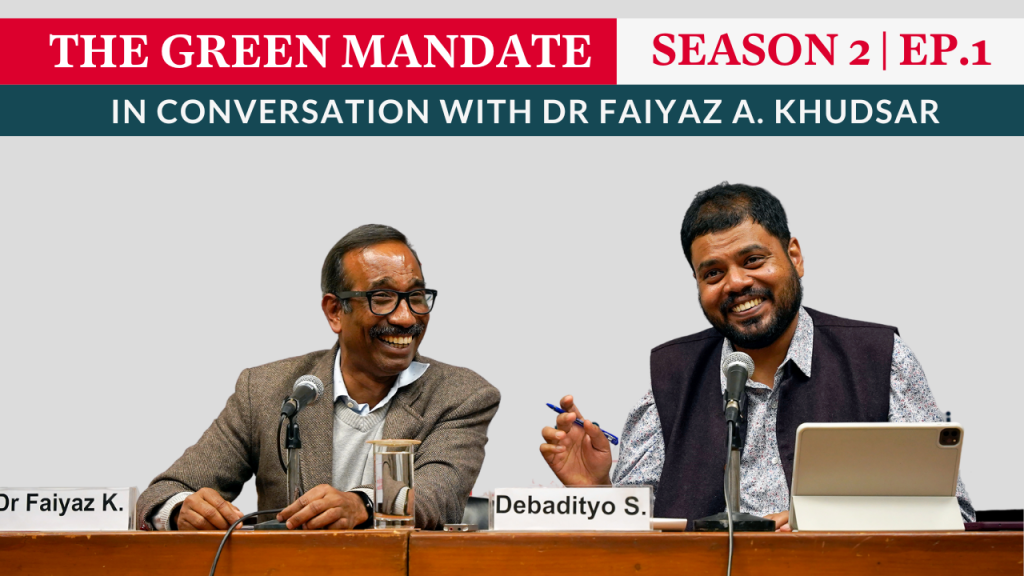
Dr. Faiyaz Khudsar in conversation with Debadityo Sinha
Question – There has been a long legal dispute regarding the understanding of forest, till today we do not have a legal definition of forest. The Supreme Court said in Godavarman judgement that we should understand forest by its dictionary meaning. What according to you as a scientist is the definition of forest?
‘Not all brown is bad and not all green is good’
Dr. Faiyaz Khudsar
Dr Khudsar highlights that when you look at the standard definition of the term forest it itself suggests that it is incomplete. Predominantly when definitions talk about forest, they talk about trees, a land full of trees. However, when you look at a forest, it is a large congregation of vegetation, which is arranged as top canopy, middle story, under story and ground vegetation. But the dictionary definition is needed by the Court in order to decide the disputes pending before it. The only way the Court can reach a decision is when you provide a certain area, then you look at the density and canopy of that area. But in a scientific context, a forest is not just a congregation of trees.
Question – The terms forestation, plantation, reforestation, and afforestation are used interchangeably in judgements and various policy documents. Whereas the ecologists suggest that we should focus on ecological restoration and not afforestation because afforestation at times causes more damage. Can you explain why we should focus on eco restoration rather than afforestation and reforestation?
Dr Khudsar highlights the importance of understanding the terms reforestation and afforestation. Afforestation as the name suggests is an area which was historically not a forest where you start the plantation process. Whereas reforestation refers to a historical forest area which is degraded where you start planting. But these plantations across the country are nothing but an amalgamation of a few tree species. For example, two to three native species along with many exotic species, in Jharkhand the Government department has used the species which do not die quickly, do not require large amounts of water and therefore they survive.
Afforestation and reforestation never reach a climax because it has limited ecological goods and services. Dr Khudsar highlights the need to understand the fact that every individual tree has its role in an ecosystem. If you bring a tree without looking at the ecosystem as a whole it may change the entire microbial flora of that site, mainly due to the loss of soil moisture the soil genesis will reduce. There are many ecological factors that come into play, it is not just the trees even though the trees bring many things. Therefore it is important to understand that afforestation and reforestation cannot bring perfect ecological goods and services and Delhi is an example of that. The Delhi Ridge is spread over almost 8000 hectares but 70 percent of that area is dominated by a single species Prosopis juliflora commonly known as vilayati kikar which does not allow any native species to grow. Dr Khudsar calls it an entirely ‘terrorist tree’.
‘Ecological restoration is a science where you bring back the ecosystem so that it can survive by itself’
Dr. Faiyaz Khudsar
But ecological restoration helps in restoring a damaged, degraded or even in some cases a lost ecosystem. It is based on sound ecological principles wherein ecological history of the site is of utmost importance because without taking that into account plantation of anything leads to afforestation or reforestation and not restoration. Restoration based on ecological history of a site can lead to a functional ecosystem where plants and animals interact together which gives you ecological goods and services.
Dr Khudsar gives an example of Banni Grasslands, where Prosopis juliflora has created huge problems not only for wildlife and plants but also for the neighbourhood pastoral communities. When you look at Banni, small carnivores like caracals have almost disappeared because the canopy cover is so thick, the grasses have disappeared which led to drastic decrease in their population.
Question – Afforestation is a relevant term here, especially after the establishment of CAMPA, an authority created to manage compensatory afforestation in India. Any diversion of forest requires permission from the Central Government under Section 2 of the Forest Conservation Act, which we call forest clearance. In the forest clearance, it is mandatory to plant trees in equal or multiple of that area elsewhere to compensate for the loss of forest. The focus of CAMPA is on planting trees, and increasing the forest cover. The Forest Rules encourage compensatory afforestation on degraded, notified, and unclassed forest land. In your experience, do you think the ‘compensatory afforestation’ program in India qualifies ‘afforestation’, or is it still a glorified ‘plantation’?
‘Conservation is not just planting trees. Plantation is seen as one stop solution for environmental issues’
Dr. Faiyaz Khudsar
Dr Khudsar says that law is a double-edged sword. The term degraded forest is of critical importance, however there is no rule or law which prescribes a formula to identify a degraded forest. In that scenario any and every forest can be a degraded forest. The understanding of plantation itself is very difficult, when you look at compulsory afforestation under CAMPA it says 1000 trees per hectare whereas the scientific understanding is that 1000 trees per hectare cannot be a functional ecosystem. We have been suggesting 2500-3000 vegetation per hectare which includes top and middle canopy of trees, lower storey and ground vegetation of shrubs and grasses.. And that is one of the biggest flaws in the compensatory afforestation policy. Dr Khudsar gives the example of Ladakh which is losing water due to massive plantations. In a dry area planting massive trees leads to depletion of water as they take up water due to evapotranspiration. As highlighted earlier, studying ecological history of an area is of vital importance before intervening. Moreover, compulsory afforestation under CAMPA is combined with the practice of afforestation in an entirely different state rather than a state where forest has been diverted. This will create more problems. It is important to understand that we do not have natural grasslands, we largely have what can be called cultural grasslands wherein villages are removed coupled with increased intervention to create grassland but that is not sustainable. What we essentially practise is a one trouser fits all approach from moist deciduous forest in Terai forest in Dudhwa to dry forests of Kuno National Park. It will not work, rather it will kill the entire microbial flora of the soil. Additionally, this practice leads to a two fold damage, first at the site of forest diversion and second at the site of compensatory afforestation.
Question – Do you think the problem is partly because of the short-sightedness of any plantation or eco-restoration programs which are making such programs just a mere formality? Is there a real financial or logistical roadblock or is it just ignorance or laziness of the system as a whole?
Dr Khudsar again highlights that ecology is a science of interaction, you sit there learn and then intervene. An official order without understanding the ecological history of an area cannot bring environmental sustainability and resilience. Additionally, the higher ranking officials do not have enough time to oversee each and every work and the lower ranking officials are not trained enough or they have different objectives. For example CAMPA has allocated about 8000 rupees per plant for the past seven years. Dr Khudsar brings up the importance of a bottom up approach and says the participation of lower ranking officials i.e. forest guards, foresters and range officers is required, a solution can only be found through them. Additionally, he highlights the importance of citizens demanding a clean environment from politicians..
Question – Institutions do have a key role in guiding the ecological restoration framework in India. How active are these institutions? Are they only working in their own silos or there is hostility among the forest managers & bureaucracy towards scientific interventions, or the least are they ever consulted during the planning stage of any plantation programs in India?
‘Knowledge arrogance of academicians and power arrogance or bureaucrats are not married together’
Dr. Faiyaz Khudsar
Dr Khudsar highlights an underlying fundamental problem. Knowledge arrogance of academicians and power arrogance of bureaucrats prevent them from engaging in productive collaboration on environmental matters. Additionally, there is a need for academicians to engage in field work especially in the context of the environment along with writing research papers.
Some Selected Questions from Audience
Question – What is the role of time in bringing back an ecosystem?
Dr Khudsar highlights that as far as ecological restoration is concerned, time is of critical importance. For example a ten or less years old tree should be transplanted for improving the chances of its survival, a tree which is older than ten years cannot provide ecological goods and services upon transplantation. We conceptualised a model of a biodiversity park wherein assemblage of species is brought to reduce succession. Succession plays an important role in ecology. In the biodiversity park model we try to facilitate how the ecological services can be brought within seven to eight years. In that context assemblage of species becomes particularly important. And this process will be based on the ecological history of an area.
Question – Can the ecological restoration sites contribute in adding to the climate resilience of a local climate?
Dr Khudsar highlights the research results from Yamuna Biodiversity Park. When the Air Quality Index in Jahangirpuri was above 500, it was less than 200 in Yamuna Biodiversity Park. We are conducting extensive research with NEERI the results of which will come out soon. Biodiversity parks are very functional entities in terms of adaptation and climate resilience. When the number migratory bird species have reduced in the entire Northern region, the Yamuna Biodiversity Park retains a substantial number of migratory birds including ferruginous pochard. Sea bold snakes came back after seventy years, and hog deer came back.
Question – The process of policy implementation lends itself to simplification, has it learned anything from the restoration science process. Assisted natural regeneration is a move away from just planting trees. Is it progress in terms of ecorestoration-based approaches or is it just feeding back into the simplistic way of planting trees?
Dr Khudsar stresses on the importance of where you want regeneration to take place. In forest areas we should wait for regeneration. But in degraded forest we need to look at the various ecological factors like the nature of rootstock in that area before planning an intervention. We need to support that regeneration by removing most of the biotic pressure over a period.
Question – As a practice in compensatory afforestation fast growing species are preferred over slow growing species. There are populist models like Miyawaki which give results very quickly. Can we create a functional forest ecosystem by that process?
Dr Khudsar highlights that this is the very reason compensatory afforestation is not going in the right direction. A functional ecosystem cannot be created by just planting fast growing species. A reference ecological system needs to be envisaged which includes fast growing, medium growing and slow growing trees along with grasses, herbs and shrubs for it to have functional ecological services. Plantation alone cannot create a functional ecosystem.
Question – What is your view regarding plantation of vetiveria for eco restoration in India?
It is important how you see the vetiveria itself. The ecological history of an area is fundamental in deciding whether vetiver can help in bringing about a functional ecosystem. For example in Delhi if you bring vetiveria, saccharum spontaneum and imperata together it will work well. But if you bring monoculture of trees alone, be it vetiveria it will not work. Grass has a role to play, it is not only foliage and grazing material, it has a huge root system and these roots have a beautiful fungus which will facilitate microbial flora. But that cannot be achieved with monoculture.
Question – Can there be any regulatory change made for better implementation of CAMPA rules?
The National Highway Authority is the most popular institution which goes for CAMPA. But most of the people undertaking these plantations are engineers but they do not have the expertise to oversee plantation of trees. Regulation comes through knowledge, the decision making needs people with requisite knowledge.

